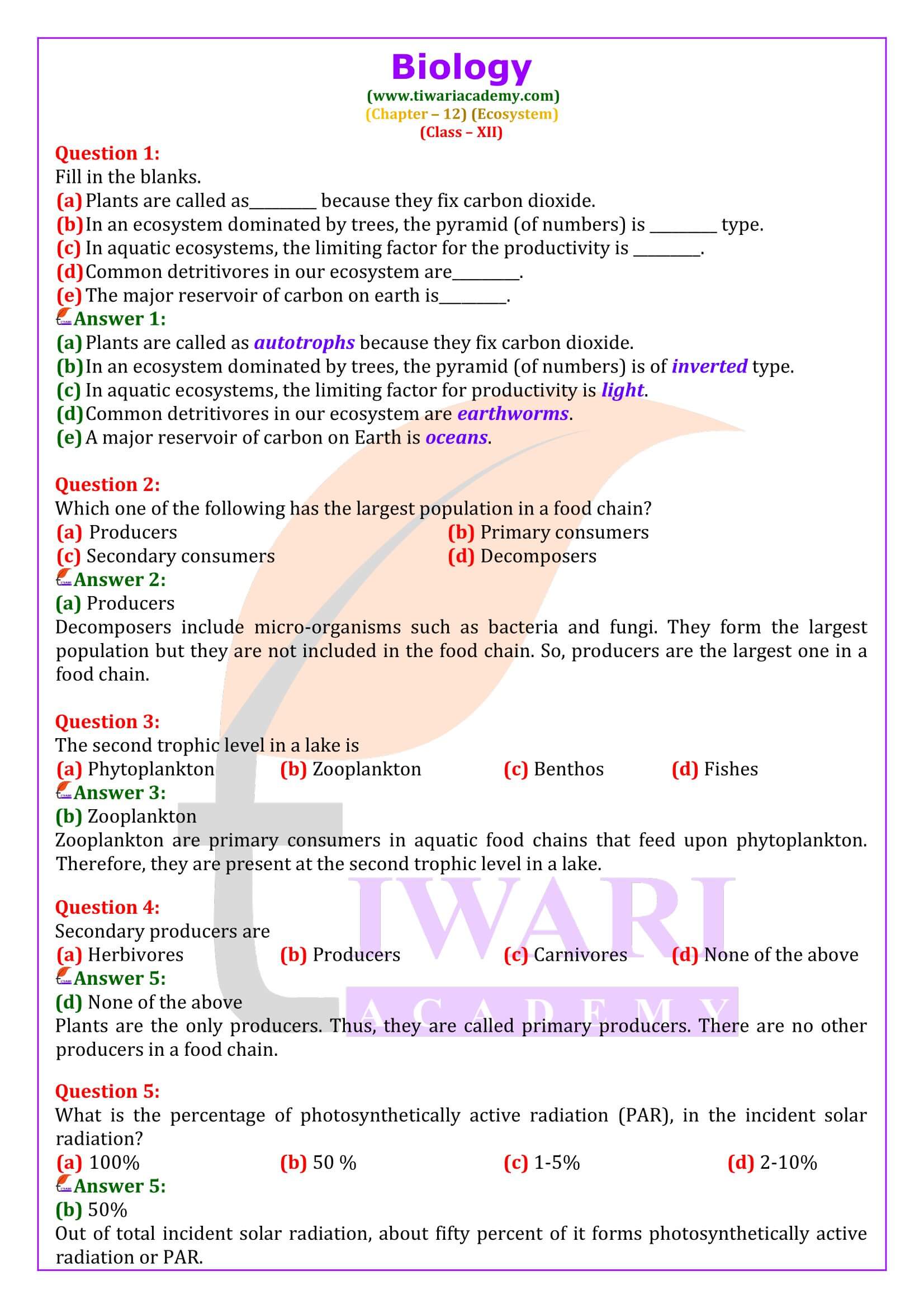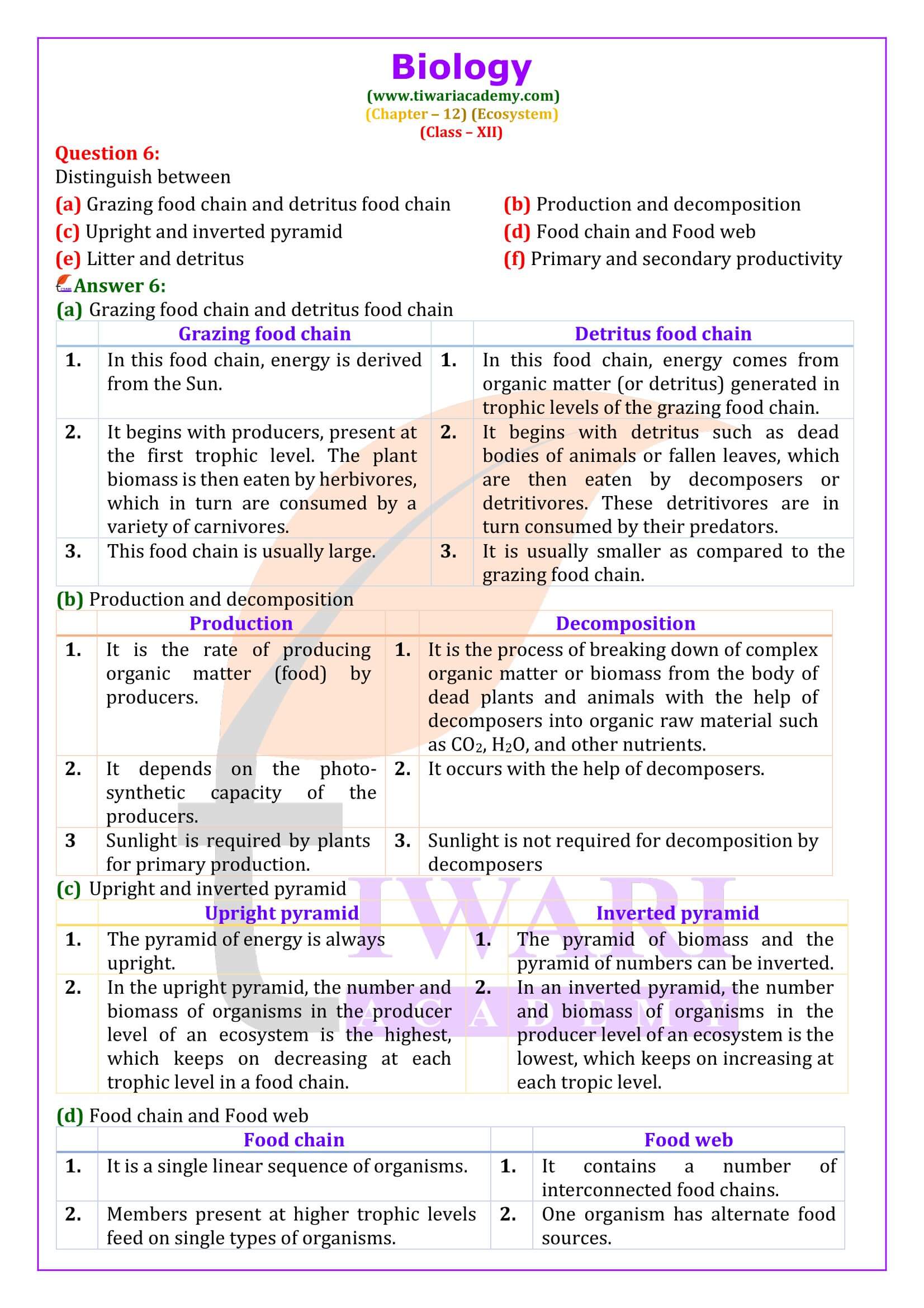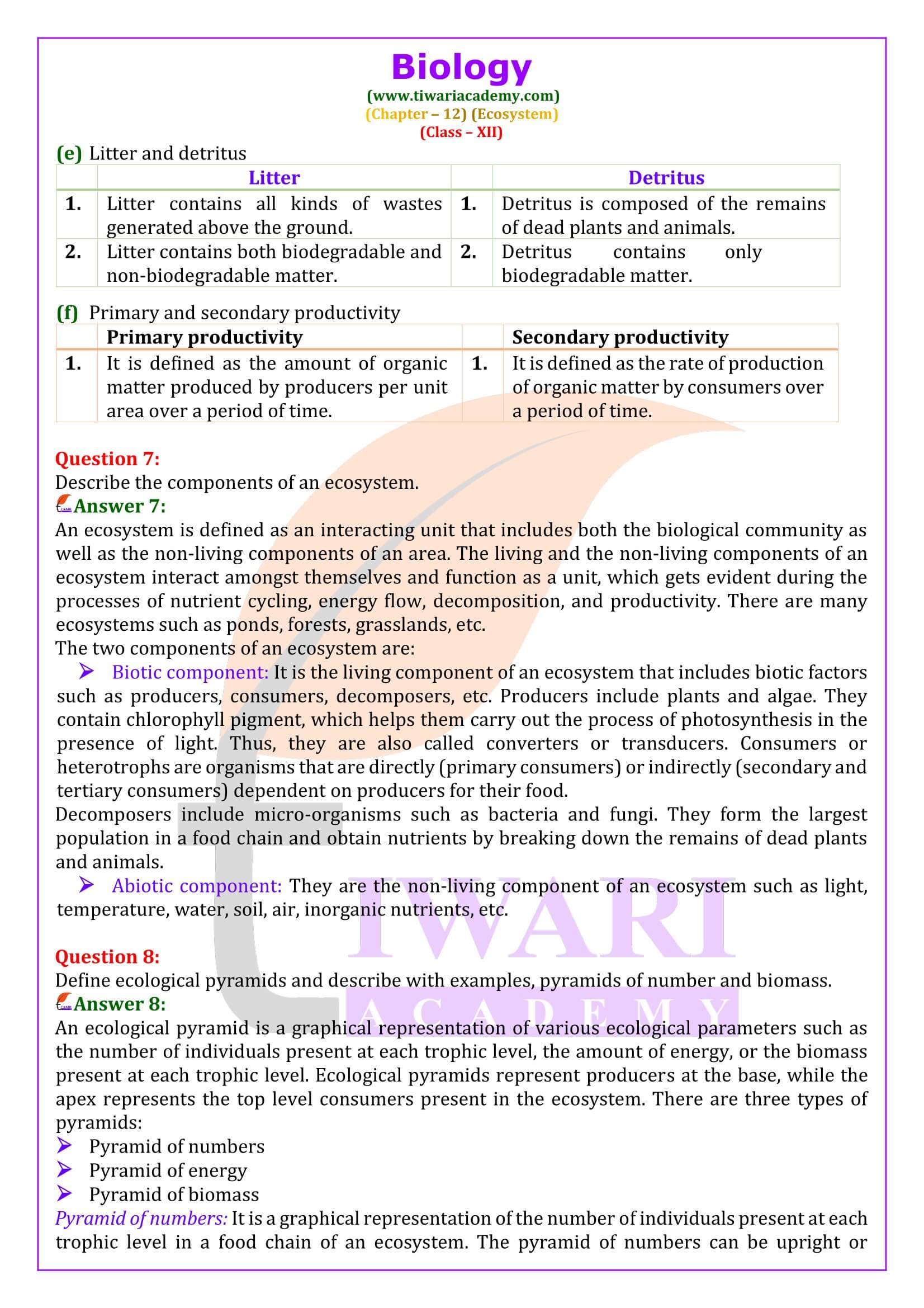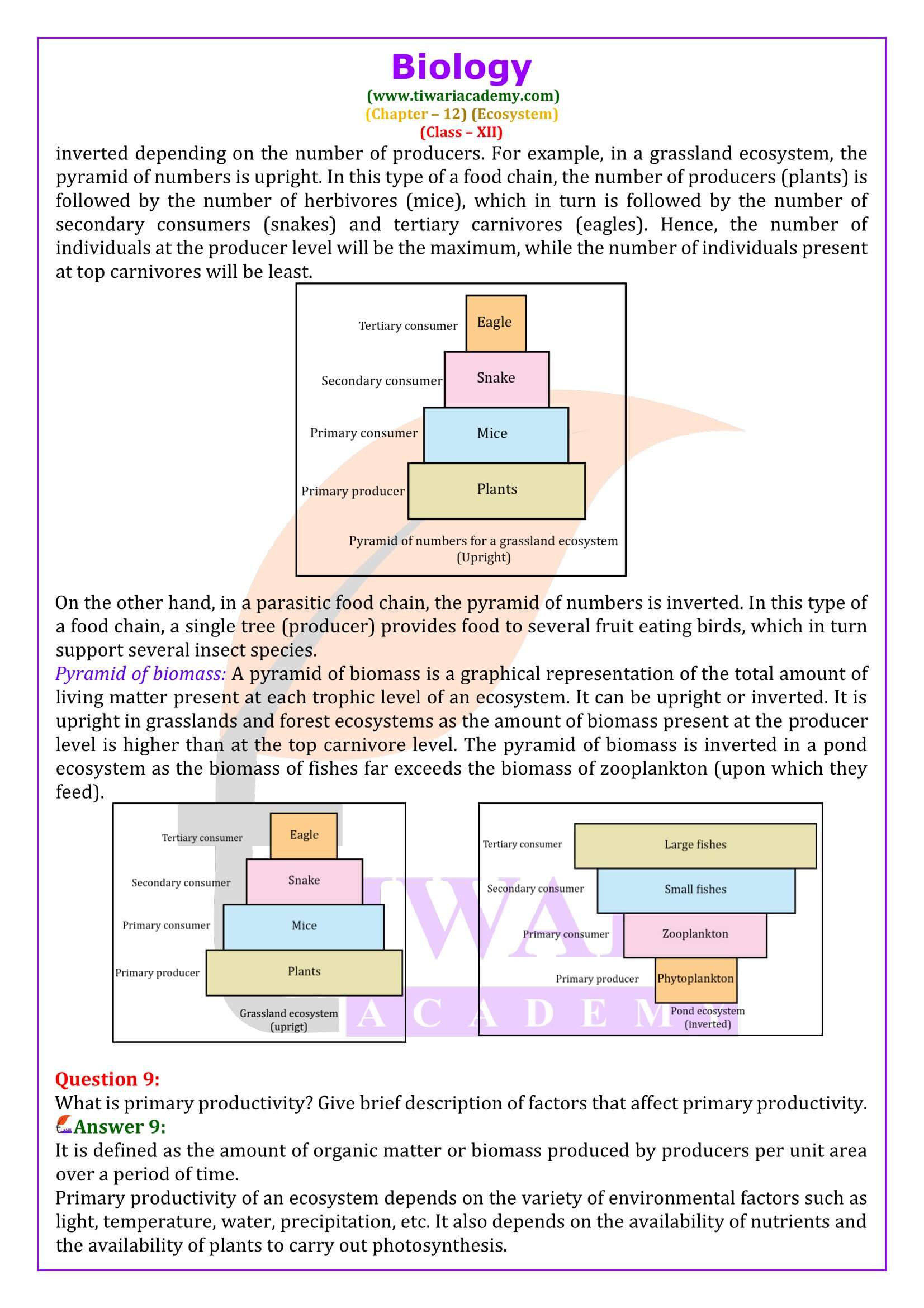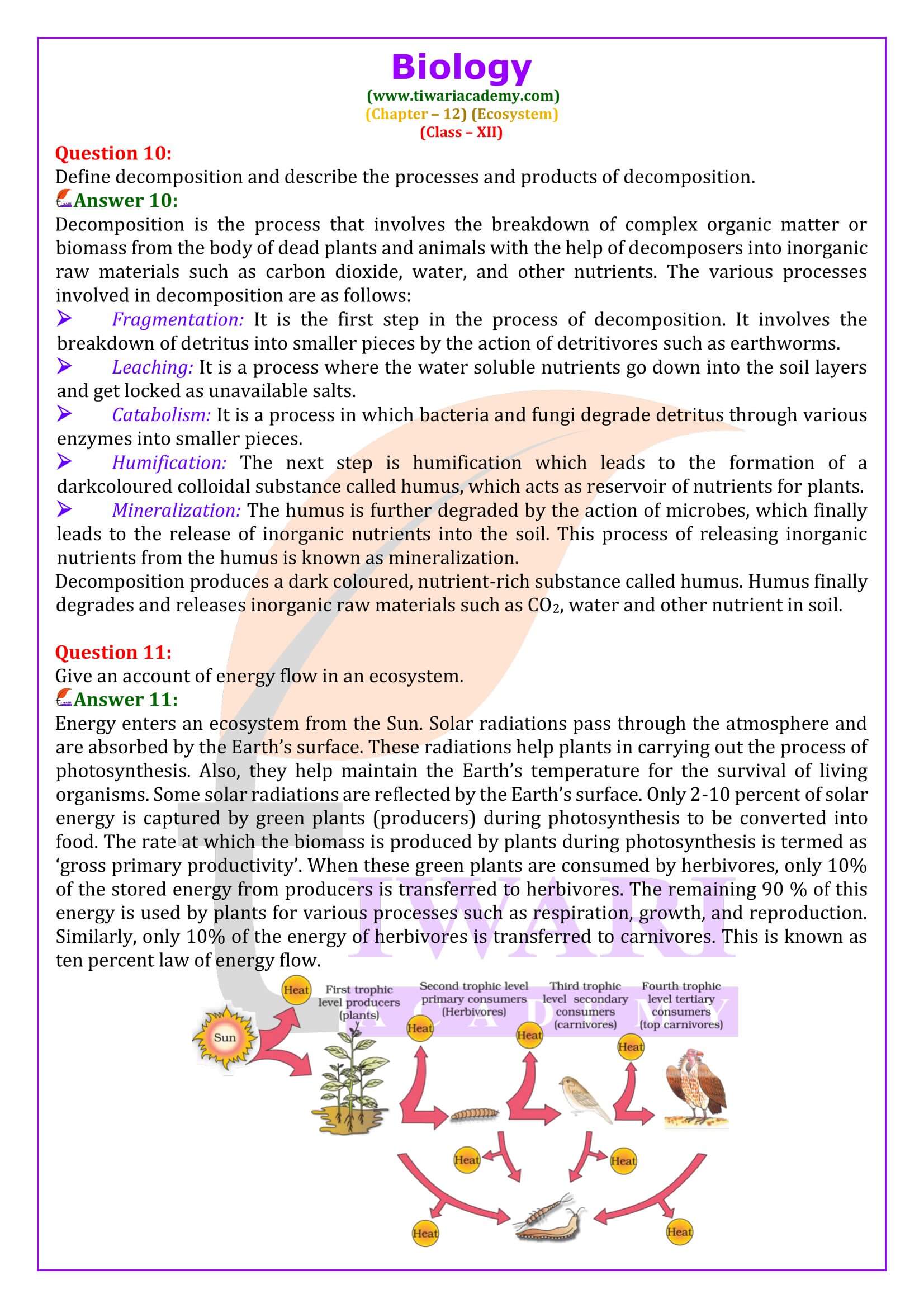NCERT Solutions for Class 12 Biology Chapter 12 Ecosystem in Hindi and English Medium download in PDF file format updated for new academic session 2024-25 following the latest CBSE Curriculum 2024-25. NCERT Books and its Solutions based on New Curriculum is also given to download. Share Your Knowledge via Discussion Forum among with your friends.
NCERT Solutions for Class 12 Biology Chapter 12
| Class: 12 | Science |
| Subject: | Biology |
| Chapter 12: | Ecosystem |
| Content Type: | Images, PDF and Videos |
| Academic Session: | 2024-25 |
| Medium: | Hindi and English Medium |
Class 12 Biology Chapter 12 Solutions in English
NCERT Solutions for Class 12 Biology Chapter 12 is given here to download in PDF format free. NCERT Solutions and Offline Apps based on these solutions are updated for new academic session 2024-25. Download NCERT Books based on latest CBSE Syllabus 2024-25. Ask your doubts through Discussion Forum and answer the questions asked by other users.
Important Terms related to Chapter 12
1. Ecosystem: It is the basic functional unit of biosphere in which living organisms interact among themselves and with their surrounding physical environment.
2. Detritus: Dead leaves, twigs, animal remains etc. constitute detritus.
Ecological succession: The successive and orderly replacement of one community by the other community in an area, over a period of time.
Stratification
Vertical distribution of different species occupying different levels in an ecosystem. Trees occupy top vertical strata, shrubs the second layer and herbs the third layer and herbs/grasses occupy the bottom layers.
1. Primary Production: Amount of biomass or organic matter produced per unit area over a time period by plants during photosynthesis.
2. Detritus: Dead leaves, twigs, animal remains etc. constitute detritus.
3. Detrivore: Organisms who break down detritus into smaller particles, e.g., earthworm.
4. Process of Decomposition: The decomposers break down complex organic matter into inorganic substances like carbon dioxide, water and nutrients. This process is called decomposition.
Productivity
1. Gross Primary Productivity: Rate of production of organic matter during photosynthesis.
2. Net Primary Productivity: NPP = GPP-R (Gross primary productivity minus the respiration losses).
3. Secondary Productivity: Rate of formation of new organic matter by consumers.
4. Climax community: The stable and final biotic community that develops at the end of ecological succession and is in perfect harmony with its physical environment.
5. Food Web: A number of food chains interconnected with each other forming a web-like pattern.
10 % Law of Energy Transfer
Ten percent law of energy transfer proposed by Lindeman. At each step of food chain, when energy is transferred from one tropic level to the next tropic level, only 10 percent of energy is passed on to the next trophic level.
Factors affecting decomposition
Decomposition is controlled by:
Chemical composition of detritus: The decomposition will slower if detritus is rich in lignin and chitin and will faster if detritus is rich in nitrogen and water soluble substance (sugar).
Climatic factors: In warm and moist environment, the process of decomposition increases whereas low temperature and anaerobiosis inhibit the decomposition.
Describe the Biotic component of an ecosystem.
An ecosystem is defined as an interacting unit that includes both the biological community as well as the non-living components of an area. The living and the non-living components of an ecosystem interact amongst themselves and function as a unit, which gets evident during the processes of nutrient cycling, energy flow, decomposition, and productivity. There are many ecosystems such as ponds, forests, grasslands, etc. The two components of an ecosystem are: Biotic component: It is the living component of an ecosystem that includes biotic factors such as producers, consumers, decomposers, etc. Producers include plants and algae. They contain chlorophyll pigment, which helps them carry out the process of photosynthesis in the presence of light. Thus, they are also called converters or transducers. Consumers or heterotrophs are organisms that are directly (primary consumers) or indirectly (secondary and tertiary consumers) dependent on producers for their food. Decomposers include micro-organisms such as bacteria and fungi. They form the largest population in a food chain and obtain nutrients by breaking down the remains of dead plants and animals.
Important Questions on 12th Biology Chapter 12
Define ecological pyramids.
An ecological pyramid is a graphical representation of various ecological parameters such as the number of individuals present at each trophic level, the amount of energy, or the biomass present at each trophic level. Ecological pyramids represent producers at the base, while the apex represents the top level consumers present in the ecosystem. There are three types of pyramids: Pyramid of numbers Pyramid of energy Pyramid of biomass.
What is primary productivity? Give brief description of factors that affect primary productivity.
It is defined as the amount of organic matter or biomass produced by producers per unit area over a period of time. Primary productivity of an ecosystem depends on the variety of environmental factors such as light, temperature, water, precipitation, etc. It also depends on the availability of nutrients and the availability of plants to carry out photosynthesis.
Write important features of a sedimentary cycle in an ecosystem.
Sedimentary cycles have their reservoirs in the Earth’s crust or rocks. Nutrient elements are found in the sediments of the Earth. Elements such as sulphur, phosphorus, potassium, and calcium have sedimentary cycles. Sedimentary cycles are very slow. They take a long time to complete their circulation and are considered as less perfect cycles. This is because during recycling, nutrient elements may get locked in the reservoir pool, thereby taking a very long time to come out and continue circulation. Thus, it usually goes out of circulation for a long time.
Outline salient features of carbon cycling in an ecosystem.
The carbon cycle is an important gaseous cycle which has its reservoir pool in the atmosphere. All living organisms contain carbon as a major body constituent. Carbon is a fundamental element found in all living forms. All biomolecules such as carbohydrates, lipids, and proteins required for life processes are made of carbon. Carbon is incorporated into living forms through a fundamental process called ‘photosynthesis’. Photosynthesis uses sunlight and atmospheric carbon dioxide to produce a carbon compound called ‘glucose’. This glucose molecule is utilized by other living organisms. Thus, atmospheric carbon is incorporated in living forms. Now, it is necessary to recycle this absorbed carbon dioxide back into the atmosphere to complete the cycle. There are various processes by which carbon is recycled back into the atmosphere in the form of carbon dioxide gas. The process of respiration breaks down glucose molecules to produce carbon dioxide gas. The process of decomposition also releases carbon dioxide from dead bodies of plants and animals into the atmosphere. Combustion of fuels, industrialization, deforestation, volcanic eruptions, and forest fires act as other major sources of carbon dioxide.
